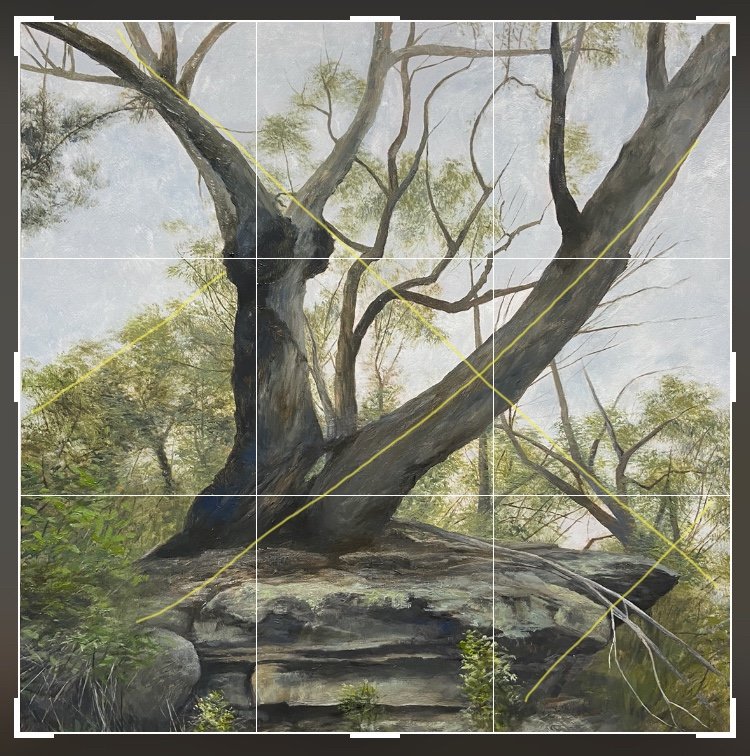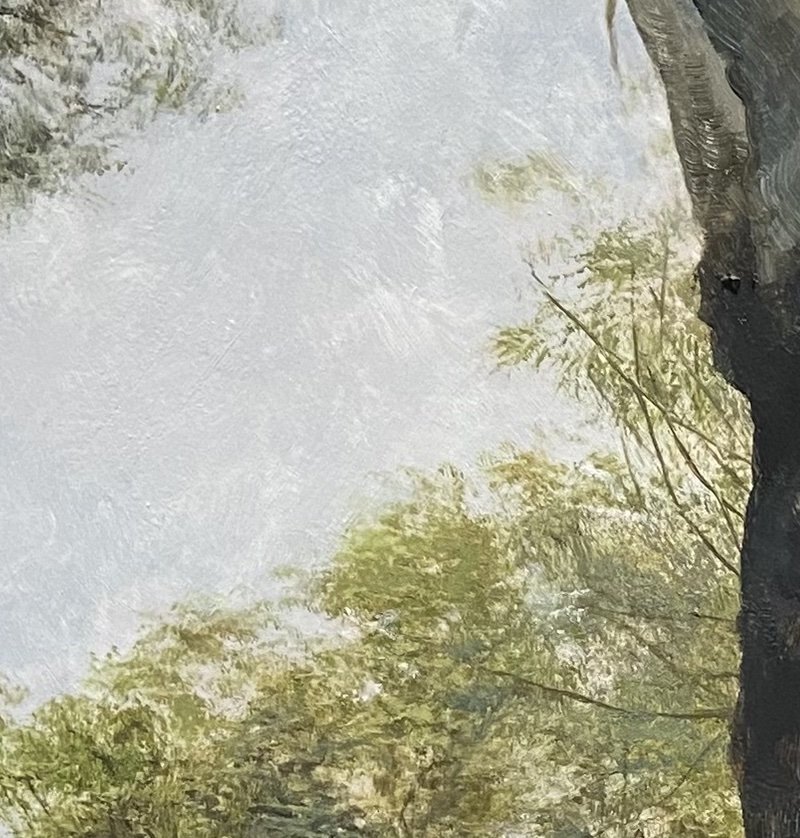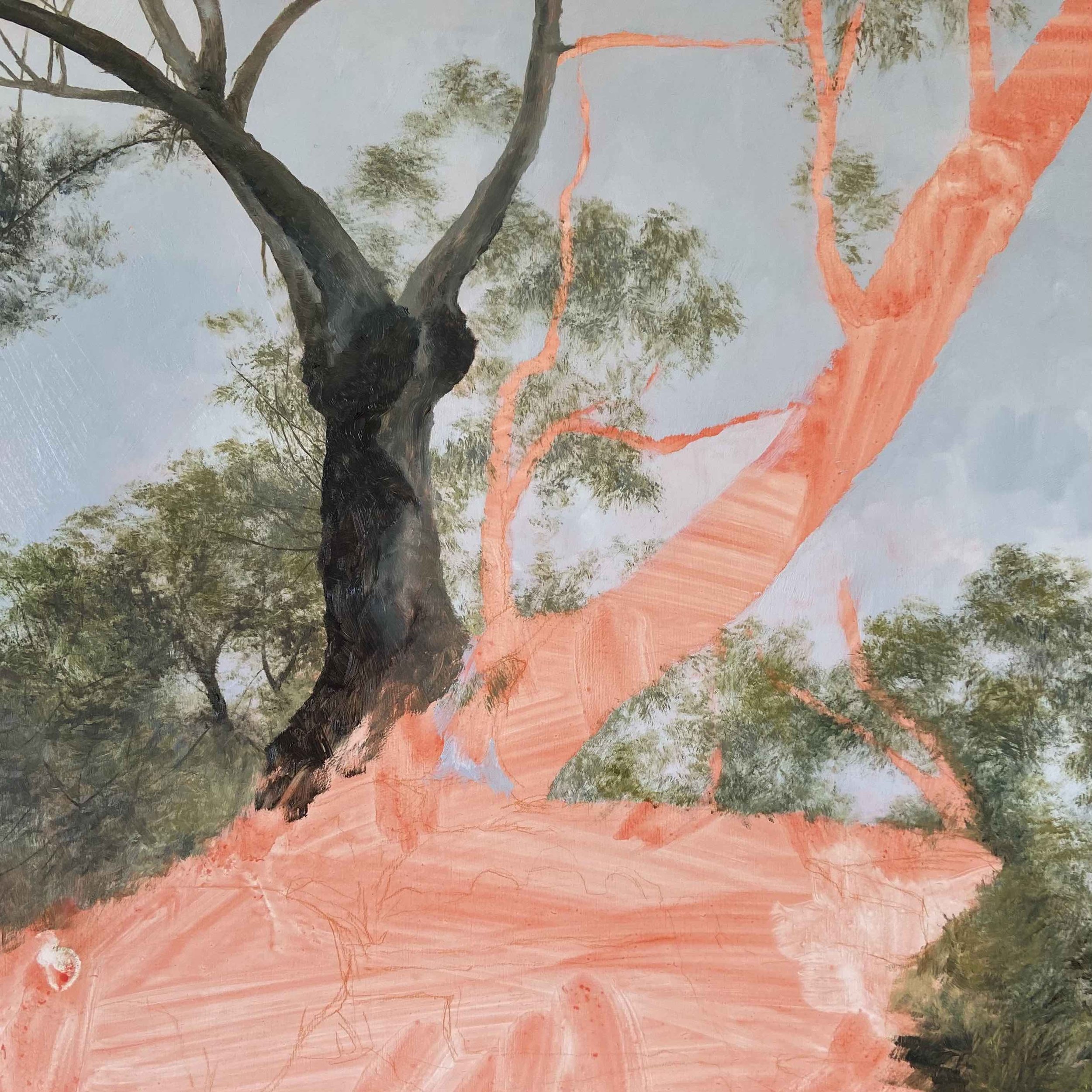The Story and Painting Technique in 'Wisdom of Trees I'
I am writing to tell you about the story and technique of this new painting, entitled 'The Wisdom of Trees I'. As you know, although I work with landscape, my paintings are imbued with meaning and resonance – both personal and archetypal symbolism. This one is no exception.
For over ten years I have walked past the tree in this painting, in the bushland near my home in the Lower Blue Mountains, west of Sydney. It has always spoken to me through its form and the seeming impossibility of its survival. As though by a miracle, it emerges from a crevice in the sandstone rock and stands serenely overlooking the valley below.
My dogs and I pass it every day on our early morning or evening walks – they bound excitedly, sniffing at each new and familiar smell. I follow at my own, steadier pace, noticing and savouring my surroundings, my senses alive to the movements of the air, the temperature, the call of birds, and the crunch of leaves beneath my feet. As I pay deep attention to the shifting shadows, the play of colour and texture, the poetry of forms, my spirit is quickened, my body grounded.
My intention is to receive, to be open to the mystery and majesty I know I will experience in this ‘unremarkable’ piece of the bush, this remarkable, yet mostly overlooked place.
There are about 78,000 people living in the Blue Mountains, and about 20,000 in the nearer vicinity, yet relatively few people ever venture into ‘the wild’ local bushland. I’m not complaining because I love silence and solitude, or more correctly, I relish the gentle, faithful companionship of the creatures and trees. Though I would be sad if this spot was suddenly inundated with people, I am curious about why so few people, who have such ready access, choose not to go into the bush to explore, relax or exercise. My best guess is that it is a combination of fear spawned by unfamiliarity and uncertainty, a lack of time or priority and most likely, that they simply don’t see the gold that sits within their grasp.
The tree in this painting offered me gold in the form of insight and validation. The symbolic resonance that it evokes – the beauty tinged with sadness and its persistent will to thrive and grow, these messages speak into my own life. A closer inspection of it reveals that at some time in its life, an ember has lodged in its core, smouldering and burning out the heart of the tree. This has devastated the integrity of the tree’s trunk, rending it in two and forcing the tree to adapt to this charred scarring. And yet, despite this traumatic event and the precarious location of the tree, it rises with grace, breathing and transpiring, shedding and regenerating, offering perches to birds and refuge to insects and other small creatures. It exemplifies resilience, balance and stability.
Making a painting of this wise tree seemed imperative, a way of honouring the knowing, abiding spirit imbued in nature and human experiences of struggle, endurance and hope. I’m sharing this story with you because I want to inspire you to venture into nature, to prioritise time and space for yourself to connect deeply with the land. My longing is that you also would walk softly in the world, touching in with your authentic self and noticing the metaphors and lessons that nature offers you.
As you do this, you may notice as I did, that your heart rate slows, a pervasive peace envelops you and you begin to experience joy and gratitude.
This is the ideal space from which to begin a creative task. You are centred and calm, connected and confident – able to take risks, show up in vulnerability, be curious, compassionate and playful. You have clarity of vision and are able both, to observe and be in your body, mind and spirit – fully inhabiting your core self.
When I started this painting, it began with the impulse to paint this particular tree and then moved to the how. I began by identifying the keynote of feeling I wanted to evoke, which then informed the composition, scale, palette (meaning colour range) and technique of applying the paint. The subject matter felt congruent with, but distinct from, a series of paintings I have recently made, of densely wooded bushlands. In those paintings, I sought to create the experience for the viewer, of being both invited in and simultaneously having their passage blocked or restricted. This mirrors the ambivalent relationship many of us have with the Australian bush - we desire to appreciate it and feel belonging, yet that is often coupled with fear of becoming overwhelmed, injured or disoriented. Those paintings were incredibly detailed, painted with tiny brushes over many days. I was exploring mark-making and in particular the complex web of marks that were needed to create texture and density in the foliage. I became fascinated by how up close the marks appeared unselfconscious and abstract, yet from a distance they coalesced, as if by a mysterious alchemy, to create a realistic image.
This painting, 'Wisdom of Trees I', is different. It’s more like a portrait of a single person, than a painting of a group or crowd. Yet, the manner of working – the detail that suggests the specificity of that one tree, and the complex build-up of marks to evoke texture, space, shape and form, is similar.
After priming the board with gesso, I covered it with a red acrylic wash and then sketched in the image, using various photographs to arrive at a composition I found pleasing. Composition is itself a complex topic and not one I have time to go into here. Suffice to say that the diagonals and the negative space in this picture are of the utmost importance to creating balance and rhythm. You might also notice I’ve employed the ‘rule of thirds’ compositional device, although this all happened intuitively, rather than through rational reasoning.
I intended the final image to be somewhat mono-chromatic, however the red underpainting serves to activate the greens and creates a visual vibration throughout the whole painting that subtly holds the viewer’s attention and curiosity. With these small pictures, this one is only 30 x 30 cm, I usually begin with the sky, filling it in with a medium-sized brush, sometimes in rough brushstrokes using both cool and warm colours. Other times I create a smoothly modulated, blended sky, which takes some practice to achieve. You may be able to see the subtle shifts in the sky where I have layered similar tints, deliberately creating visual variation, rather than a completely flat or blended colour.
At the start it can feel a little like I am simply blocking in sections of the painting, and I do this generally from the background forwards. In this painting, after the sky, I worked on the foliage in the trees behind the rock form, then the smaller trees, and the branches and trunk of the large tree. Following that, I worked on the rock, but at this point in the painting, my attention was constantly shifting around the image, adding brushstrokes, modifying shapes and colours, and developing the tapestry of marks that combine to create the whole. This is an intricate and intuitive process, where my attention is acutely focused, and my thinking shifts seamlessly between analysing and noticing what is happening with each brushstroke and responding intuitively. This is the transformative stage of the painting, where the idea or feeling I am wanting to evoke needs to somehow transcend the material reality of paint on board. This is where the magic happens and it is the most challenging and also rewarding part of the process. It is as though all the threads are lovingly and expertly handled, some are pruned, some lengthened or expanded, all are coaxed together so that each distinct one plays its part.
After days of engaging in this intriguing process, this push-pull of intuitive action and gentle cognitive exploration, this painting seemed to be finished. How did I know? That’s a question I always get asked and it’s a good one. I have a highly technical term for what I do, yet I think it is grounded in a valid understanding of how the mind and picture-making works. I look for ‘the niggles’. What I mean is that when I think a painting is nearing completion, I don’t push on that, rather I soften back into a space of receptivity and curiosity. I give the painting breathing space by letting it sit, within my peripheral vision or awareness, but no longer as the single object of my attention. And I do other activities while allowing ‘the niggles’ to simmer and bubble to the surface. And they do. As I relax my focus, I perceive and intuit with greater clarity. If I am paying attention to what comes up for me then, I see the necessary changes I need to make to the picture and know when it is finished. It is as though I am listening to the voice of the painting, which is now separate to me and has its own place in the world.
I hope you have found this story interesting, and that what I have shared may inspire you to connect with nature and your own creative longings. I am excited to be embarking on a new series of paintings following my successful exhibition at Stella Downer Fine Art in Sydney. My plan is to continue creating tree ‘portraits’ – to notice the metaphors and wisdom that trees offer me as I walk in the bush each day and to share that with you in my work.
If you liked this story and explanation, then I’d love to hear what you think. Please write a comment below to share your thoughts with me.
If you want to come and paint with me, to experience working in my studio or painting plein air, then click here to see what workshops I have coming up.



